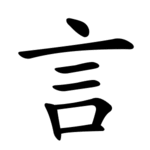⾔
From Wiktionary, the free dictionary
Remove ads
| ||||||||
| ||||||||
Note that in Japanese and Korean (printed forms), the 亠 component on top is written 二 (as found in the Kangxi dictionary). In traditional/simplified Chinese and Vietnamese, the top component is written 丶. In written Japanese, the top component may be written either 一, 丶 or 丨 (small vertical stroke).
言 (Kangxi radical 149, 言+0, 7 strokes, cangjie input 卜一一口 (YMMR), four-corner 00601, composition ⿳亠𠄠口(GHTV) or ⿱亖口(JK))
| Historical forms of the character 言 | |||
|---|---|---|---|
| Shang | Western Zhou | Shuowen Jiezi (compiled in Han) | Liushutong (compiled in Ming) |
| Oracle bone script | Bronze inscriptions | Small seal script | Transcribed ancient scripts |
 |
 |
 |
 |
Ideogram (指事) : 言 was created by adding a horizontal stroke to the top of the ancient version of 舌 to indicate movement of the tongue.[1] This indicates speech, where 舌 is a mouth (口) with a tongue sticking out; hence 舌 doesn't indicate the speech, but the tongue as an organ of the body. In the modern version, another horizontal stroke (then stylized as a point) was added on top and the vertical body of the tongue disappeared. See also 音.
Shuowen erroneously analyzes the glyph as a phono-semantic compound (形聲 / 形声) : phonetic 䇂 () + semantic 口 (“mouth”).
According to Schuessler (2007: 74) this word is derived from 語 (OC *ŋaʔ, “to speak”) + -n nominal suffix.
| Variety | Location | 言 |
|---|---|---|
| Mandarin | Beijing | /iɛn³⁵/ |
| Harbin | /ian²⁴/ | |
| Tianjin | /ian⁴⁵/ | |
| Jinan | /iã⁴²/ | |
| Qingdao | /iã⁴²/ | |
| Zhengzhou | /ian⁴²/ | |
| Xi'an | /iã²⁴/ | |
| Xining | /iã²⁴/ | |
| Yinchuan | /ian⁵³/ | |
| Lanzhou | /iɛ̃n⁵³/ | |
| Ürümqi | /ian⁵¹/ | |
| Wuhan | /iɛn²¹³/ | |
| Chengdu | /ian³¹/ | |
| Guiyang | /ian²¹/ | |
| Kunming | /iɛ̃³¹/ | |
| Nanjing | /ien²⁴/ | |
| Hefei | /iĩ⁵⁵/ | |
| Jin | Taiyuan | /ie¹¹/ |
| Pingyao | /ȵie̞¹³/ | |
| Hohhot | /ie³¹/ | |
| Wu | Shanghai | /ɦi²³/ |
| Suzhou | /ɦiɪ¹³/ | |
| Hangzhou | /ɦiẽ̞²¹³/ | |
| Wenzhou | /ȵi³¹/ | |
| Hui | Shexian | /ne⁴⁴/ |
| Tunxi | /ȵiɛ⁴⁴/ | |
| Xiang | Changsha | /iẽ¹³/ |
| Xiangtan | /ȵiẽ¹²/ | |
| Gan | Nanchang | /ȵiɛn⁴⁵/ |
| Hakka | Meixian | /ŋian¹¹/ |
| Taoyuan | /ŋien¹¹/ | |
| Cantonese | Guangzhou | /jin²¹/ |
| Nanning | /jin²¹/ | |
| Hong Kong | /jin²¹/ | |
| Min | Xiamen (Hokkien) | /gian³⁵/ |
| Fuzhou (Eastern Min) | /ŋyoŋ⁵³/ | |
| Jian'ou (Northern Min) | /ŋyiŋ³³/ | |
| Shantou (Teochew) | /ŋaŋ⁵⁵/ | |
| Haikou (Hainanese) | /ŋin³¹/ /ŋin²¹³/ 俗 /kɔŋ²¹³/ 訓講 |
| Rime | |
|---|---|
| Character | 言 |
| Reading # | 1/1 |
| Initial (聲) | 疑 (31) |
| Final (韻) | 元 (65) |
| Tone (調) | Level (Ø) |
| Openness (開合) | Open |
| Division (等) | III |
| Fanqie | 語軒切 |
| Baxter | ngjon |
| Reconstructions | |
| Zhengzhang Shangfang |
/ŋɨɐn/ |
| Pan Wuyun |
/ŋiɐn/ |
| Shao Rongfen |
/ŋiɐn/ |
| Edwin Pulleyblank |
/ŋɨan/ |
| Li Rong |
/ŋiɐn/ |
| Wang Li |
/ŋĭɐn/ |
| Bernhard Karlgren |
/ŋɨ̯ɐn/ |
| Expected Mandarin Reflex |
yán |
| Expected Cantonese Reflex |
jin4 |
| Baxter–Sagart system 1.1 (2014) | ||||
|---|---|---|---|---|
| Character | 言 | 言 | 言 | 言 |
| Reading # | 1/4 | 2/4 | 3/4 | 4/4 |
| Modern Beijing (Pinyin) |
yán | yán | yán | yán |
| Middle Chinese |
‹ ngjon › | ‹ ngjon › | ‹ ngjon › | ‹ ngjon › |
| Old Chinese |
/*ŋa[n]/ | /*ŋa[n]/ | /*ŋa[n]/ | /*ŋa[r]/ |
| English | (a particle) | I, we | speak; speech | tall |
Notes for Old Chinese notations in the Baxter–Sagart system: * Parentheses "()" indicate uncertain presence; | ||||
| Zhengzhang system (2003) | |
|---|---|
| Character | 言 |
| Reading # | 1/1 |
| No. | 14271 |
| Phonetic component |
言 |
| Rime group |
元 |
| Rime subdivision |
1 |
| Corresponding MC rime |
言 |
| Old Chinese |
/*ŋan/ |
言
From Middle Chinese 言 (MC ngjon, “speech”).
Cognate with 事 (koto, “thing”).[4]
From Middle Chinese 言 (MC ngjon).
Wikisource 言 (eumhun 말씀 언 (malsseum eon))
Related to Middle Chinese 誾 (MC ngin).
言 (kutu)
Seamless Wikipedia browsing. On steroids.
Every time you click a link to Wikipedia, Wiktionary or Wikiquote in your browser's search results, it will show the modern Wikiwand interface.
Wikiwand extension is a five stars, simple, with minimum permission required to keep your browsing private, safe and transparent.
